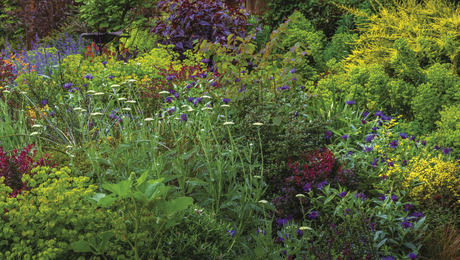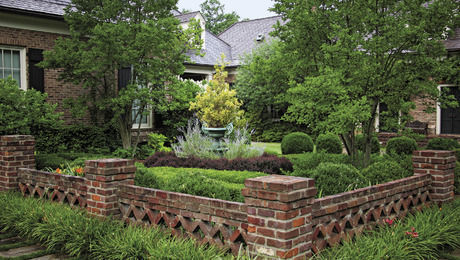
My ideal garden is a serene place, one in which I feel connected to the natural world through rich, sensory experiences. It is a place that generates a sense of well-being. Creating a diverse, densely planted, layered garden with some mystery and some surprise is the intention. Drawing from some of my most memorable experiences in nature, I want the garden to provide a habitat for insects, frogs, birds, and other creatures while also being a space for people. These have been the goals I have worked toward in my garden in Glen Echo, Maryland. I have found that creating a peaceful garden comes from setting the mood from the first step into the garden and carrying it through with a soothing color palette, an easy pace, and a variety of sensory experiences.
Serenity in the suburbs

A garden can be a place of calm reflection even if you live on a busy suburban lot. Plants and water features filter out views and noise while inviting the soothing presence of birds, frogs, and other wildlife.
Set the mood right from the beginning


Living in a friendly neighborhood, I wanted to welcome neighbors coming into the house, as well as those walking by, with an entrance that is open and approachable. Our 3½-foot fence is high enough to define the space and low enough to allow passersby to see the interesting flowers and textured plants. The front garden also is lower than the sidewalk, inviting all to look in and discover the stone edging and diamond-paving pattern. Keeping the front garden as an open space with lawn down the middle adds to the welcoming feeling that draws guests into our garden. The informality in the plantings helps to soften the garden.
Once inside the front, one notices an arch of weeping Norway spruce (Picea abies ‘Pendula’, USDA Hardiness Zones 3–8) framing a three-tiered fountain in the corner. Acting as a focal point, the fountain pulls you along to the next space on the garden journey. The shade and the fountain’s gently falling water make this a peaceful place, which is why we call it “the meditation garden.” This garden is surrounded by a mixed hedge, creating a space that feels like a room isolated from other parts of the garden. The symmetry and balance of the space are soothing to the eye. The fountain is 5 feet tall and, in order to get the proportions exactly right, the outer edge of the brick base is 5 feet in diameter. The inner circle of brick is just wide enough to insure that the water creates a gentle splash on the brick after it falls, for a sense of coolness and refreshment, as well as a place for a variety of mosses and plants to grow. Hardy begonia (Begonia grandis, Zones 6–9) and creeping saxifrage (Saxifraga stolonifera, Zones 6–9) seem to grow happily nestled into the brick crevices.
Keep things interesting but calm
Nearby is a bench to sit on and absorb the peaceful sounds of the water. From here, you can look out over the garden to watch an array of birds and take in the rich layers of plantings along the terrace leading down to the moss garden. The steps going down the slope toward the moss garden also function as a part of the terrace design. They are gentle, with a long tread (4 feet) and a low riser (6½ inches), following the existing slope so the walk is slow and the garden can be enjoyed along the way.

This elevation change makes it easy to see the rich and varied tapestry of plants including a variety of ferns and native grasses. Green is the color of choice in my garden, and the plants I choose create richness through their forms, textures, and shapes. I use occasional colorful annuals and bulbs as highlights, surprises, or as accents to move the eye or, in the case of gold foliage, to lighten dark spaces.
The moss garden and the Buddha sculpture at the base of the terrace provide a kind of landing for the eye while enticing you to move along to the base. The moss garden is primarily variations of green and truly looks beautiful in four seasons due to the careful selection of contrasting evergreens such as camellias (Camellia spp. and cvs., Zones 6–10), conifers, and Japanese laurels (Aucuba japonica and cvs, Zones 7–9) along with different varieties of moss. Initially, this central landing area was planted with lawn. When the moss wanted to grow instead, it was logical to convert it to a moss lawn. The key to keeping it beautiful is to keep it weeded and not let the autumn leaves stay on it for too long. Moss is richer and more textured than lawn. It upholsters the landscape with the added benefit of not needing to be mowed. The Buddha sculpture stands at just the right place and setting where its color pulls you along the journey and lights the dark space.
On many previous occasions, I had to fight my desire to buy various garden ornaments for the garden. In hindsight, I see that they would not have added to the sense of peacefulness. More likely, if I had not had restraint in the choice and selection of garden ornaments, the garden would have become busy and less serene.
Make the end worth the journey
Last along the journey is the waterfall garden, designed with a blend of Asian and western sensibilities. It starts with a stream that meanders into a small, naturalistic pool and then into a rectangular pool with artistically arranged stone. We created a sense of depth here by using large-leaved, bold-textured plants toward the back of the waterfall. This gives the illusion that the space is bigger than it really is. We tweaked the specific placement of stone within the stream and waterfall, along with the power of the pump (1 horsepower), to provide pleasing water music reminiscent of mountain streams.
In order for the water garden to be a rich habitat, we use a skimmer filter, ultraviolet light, but no chlorine. Several kinds of frogs and toads come to the pool every year for breeding, it is home to many rescued fish, and it is a central watering hole for birds who create nests in nearby plants.

A sense of enclosure created by the outer plantings adds to the feeling of being in another, more serene world. Since our county laws require a minimum 6-foot-high fence around a pool area, we used mixed tall plantings on the outer perimeter of the three sides that are fenced. This provides privacy and a pleasing backdrop for lower garden plants. Since we live in fairly close quarters with neighbors, this combination contributes to the sense that the garden is an oasis.
Continuity of materials is really important in a garden so that it isn’t a hodgepodge of miscellaneous, unrelated materials. Our garden uses native granite stone, flagstone, and old brick throughout. Repetition in the garden gives a sense of continuity—an essential ingredient to keep the garden calm.
From the porch looking out over the garden, the quality of light and air delights the senses. Dappled light dances through the shimmering leaves, golden light highlights plants as the sun moves, delightful sounds hum from a wide variety of birds and the waterfalls, and smells waft up from hidden flowers—all this gives a sense of peacefulness. Being in the garden creates a feeling of timelessness. It is a natural sanctuary, a place where it is possible to experience a close connection with the natural world.
Holly H. Shimizu is the former executive director at the U.S. Botanic Garden.
Photos: Steve Aitken; Neil Soderstrom. Illustrations: Kate Gosselin

















Comments
Log in or create an account to post a comment.
Sign up Log in